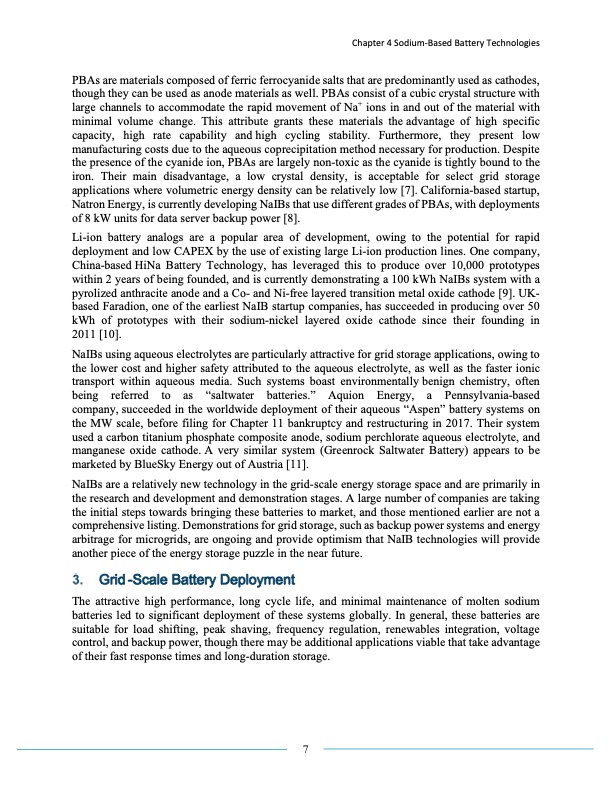
PDF Publication Title:
Text from PDF Page: 007
PBAs are materials composed of ferric ferrocyanide salts that are predominantly used as cathodes, though they can be used as anode materials as well. PBAs consist of a cubic crystal structure with large channels to accommodate the rapid movement of Na+ ions in and out of the material with minimal volume change. This attribute grants these materials the advantage of high specific capacity, high rate capability andhigh cycling stability. Furthermore, they present low manufacturing costs due to the aqueous coprecipitation method necessary for production. Despite the presence of the cyanide ion, PBAs are largely non-toxic as the cyanide is tightly bound to the iron. Their main disadvantage, a low crystal density, is acceptable for select grid storage applications where volumetric energy density can be relatively low [7]. California-based startup, Natron Energy, is currently developing NaIBs that use different grades of PBAs, with deployments of 8 kW units for data server backup power [8]. Li-ion battery analogs are a popular area of development, owing to the potential for rapid deployment and low CAPEX by the use of existing large Li-ion production lines. One company, China-based HiNa Battery Technology, has leveraged this to produce over 10,000 prototypes within 2 years of being founded, and is currently demonstrating a 100 kWh NaIBs system with a pyrolized anthracite anode and a Co- and Ni-free layered transition metal oxide cathode [9]. UK- based Faradion, one of the earliest NaIB startup companies, has succeeded in producing over 50 kWh of prototypes with their sodium-nickel layered oxide cathode since their founding in 2011 [10]. NaIBs using aqueous electrolytes are particularly attractive for grid storage applications, owing to the lower cost and higher safety attributed to the aqueous electrolyte, as well as the faster ionic transport within aqueous media. Such systems boast environmentally benign chemistry, often being referred to as “saltwater batteries.” Aquion Energy, a Pennsylvania-based company, succeeded in the worldwide deployment of their aqueous “Aspen” battery systems on the MW scale, before filing for Chapter 11 bankruptcy and restructuring in 2017. Their system used a carbon titanium phosphate composite anode, sodium perchlorate aqueous electrolyte, and manganese oxide cathode. A very similar system (Greenrock Saltwater Battery) appears to be marketed by BlueSky Energy out of Austria [11]. NaIBs are a relatively new technology in the grid-scale energy storage space and are primarily in the research and development and demonstration stages. A large number of companies are taking the initial steps towards bringing these batteries to market, and those mentioned earlier are not a comprehensive listing. Demonstrations for grid storage, such as backup power systems and energy arbitrage for microgrids, are ongoing and provide optimism that NaIB technologies will provide another piece of the energy storage puzzle in the near future. Grid -Scale Battery Deployment The attractive high performance, long cycle life, and minimal maintenance of molten sodium batteries led to significant deployment of these systems globally. In general, these batteries are suitable for load shifting, peak shaving, frequency regulation, renewables integration, voltage control, and backup power, though there may be additional applications viable that take advantage of their fast response times and long-duration storage. 7 Chapter 4 Sodium-Based Battery TechnologiesPDF Image | SODIUM-BASED BATTERY TECHNOLOGIES CH 4

PDF Search Title:
SODIUM-BASED BATTERY TECHNOLOGIES CH 4Original File Name Searched:
ESHB_Ch4_Sodium_Spoerke-1.pdfDIY PDF Search: Google It | Yahoo | Bing
Salgenx Redox Flow Battery Technology: Salt water flow battery technology with low cost and great energy density that can be used for power storage and thermal storage. Let us de-risk your production using our license. Our aqueous flow battery is less cost than Tesla Megapack and available faster. Redox flow battery. No membrane needed like with Vanadium, or Bromine. Salgenx flow battery
| CONTACT TEL: 608-238-6001 Email: greg@salgenx.com | RSS | AMP |